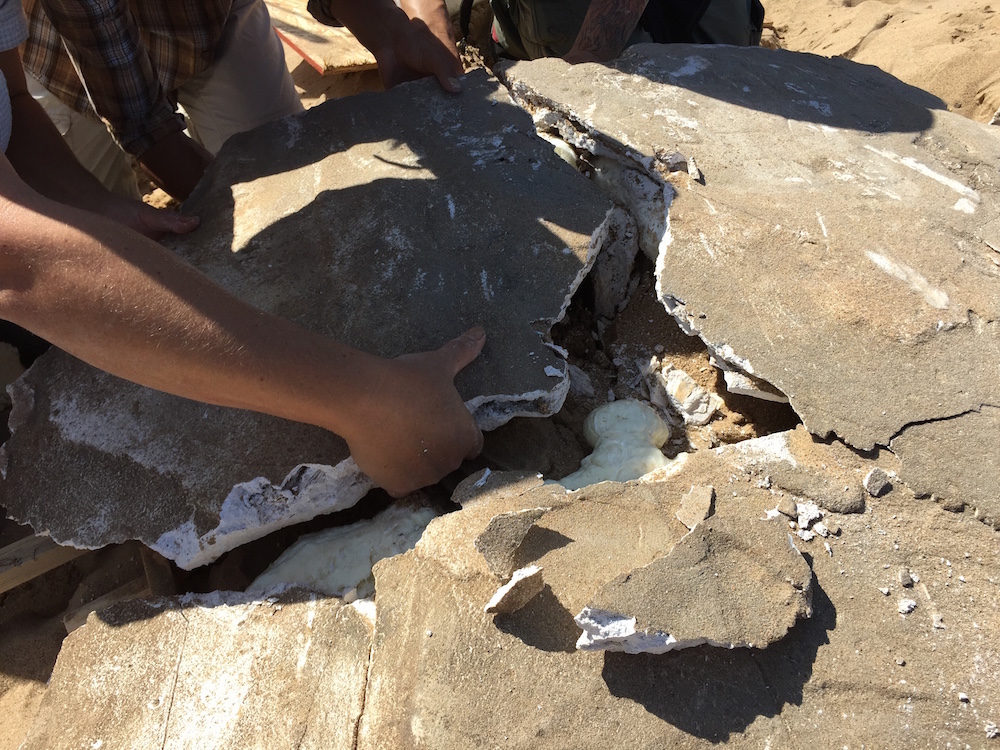Forgotten 1920s 'Ten Commandments' Sphinx Gets a Hollywood Ending

After spending more than 90 years in the sandy dunes of Guadalupe, California, a majestic plaster Hollywood sphinx, created for the 1923 blockbuster silent film "The Ten Commandments," is making its 21st century debut.
Researchers excavated the fragile plaster of Paris sphinx from the dunes in 2014, and let it dry for several months before art restorers used Elmer's Glue to piece it back together. It's now housed at the Guadalupe-Nipomo Dunes Center in Southern California, and goes on display for the public tomorrow evening (June 12).
"It's been pretty phenomenal," said Doug Jenzen, the executive director of the Guadalupe-Nipomo Dunes Center. "We're putting the final touches on the exhibit right now." [See Photos of the Old and Refurbished Hollywood Sphinxes]
The sphinx and its companions were the brainchild of director Cecil B. DeMille and his film crew. The silent movie had an enormous set to show the grandeur of Pharaoh's City, which was lined with 21 regal sphinxes, each standing 35 feet (11 meters) tall when they were on their pedestals.
Artifacts left by the crew suggest they had a good time on the set while making the movie. Archaeologists found tobacco tins and medicine bottles — the latter likely a ruse that carried moonshine because "The Ten Commandments" was filmed during America's Prohibition Era (1920-1933), when alcohol wasn't allowed, Jenzen said.
After filming ended, the crew apparently left the movie set to the elements. The statues were weathered by the rain, fog and wind and eventually buried by the sand on the ever-shifting dunes.
"In the process of putting [the sphinx] back together, the art restorer also found graffiti on it that said 'May 1930,'" Jenzen told Live Science. "It corresponds to all of the photos we have of people in the 1930s going out to the dunes and posing with these Egyptian statues that are sticking out of the sand."
Get the world’s most fascinating discoveries delivered straight to your inbox.
The researchers also found evidence that people used the sphinxes for target practice, Jenzen said. They also uncovered a burned piece of toast, likely from an uneaten 1920s sandwich.
"Somehow this piece of toast made it through the elements of being exposed," Jenzen said. "It's definitely not edible anymore."
Sphinx restoration
Artifacts stay better preserved under dry desert conditions. But Guadalupe is naturally humid, giving researchers a unique challenge.
"The minute the plaster statuary is exposed to the humidity in the air, it turns to mush and crumbles," Jenzen said. "So you need to have a team of people there who are able to pull the sand away and excavate it all simultaneously."
But hiring a large crew of people is expensive; the small team involved only had time to excavate part of the sphinx — half of its chest and hind legs. [Photos: Uncovering Sphinxes from 1923 'The Ten Commandments']
They also excavated it in a very California-like way. They wrapped the plaster in foam and pillows to protect it, and the placed it on plywood that had surfboards underneath it.
"The surfboards acted as sleds," Jenzen said. "It's an ecologically sensitive area and we couldn't have any cars or vehicles on it."
They let the partial sphinx sit inside for several months, letting it dry out and shrink to its original size. Then, restorers spent about five weeks piecing the chucks together with Elmer's Glue, largely because it's reversible, said Amy Higgins, an art restorer who worked on the sphinx.
The sphinx was in about 50 pieces, and she called "the fragility of it" the most challenging part. But now it sits about 10.5 feet long, 4.5 feet high and 3.5 feet deep, (3.2 by 1.4 by 1 meters).
In the meantime, researchers took a trip to the Academy of Motion Picture Arts and Sciences in Beverly Hills, and ended up looking through about 1,500 photographs that DeMille had taken of the set so they would have a better idea of the sphinxes' production, Jenzen said.
"There's one picture that we found, it's kind of funny. It's a bunch of guys going to work one morning out in the dune, and the whole dune was just littered with sphinx parts."
The new exhibit will show photos from the Academy of Motion Picture Arts and Sciences, as well as the sphinx body, and a sphinx face and paw.
After seeing the exhibit, enthusiasts may also want to see "The Lost City of Cecil B. DeMille," a new movie about the making of the movie by Peter Brosnan, Jenzen said. They can also see a paw of another sphinx that the researchers mailed to the U.S. Department of the Interior's POP! Exhibit in Washington, D.C., he added.
Follow Laura Geggel on Twitter @LauraGeggel. Follow Live Science @livescience, Facebook & Google+. Original article on Live Science.

Laura is the managing editor at Live Science. She also runs the archaeology section and the Life's Little Mysteries series. Her work has appeared in The New York Times, Scholastic, Popular Science and Spectrum, a site on autism research. She has won multiple awards from the Society of Professional Journalists and the Washington Newspaper Publishers Association for her reporting at a weekly newspaper near Seattle. Laura holds a bachelor's degree in English literature and psychology from Washington University in St. Louis and a master's degree in science writing from NYU.



